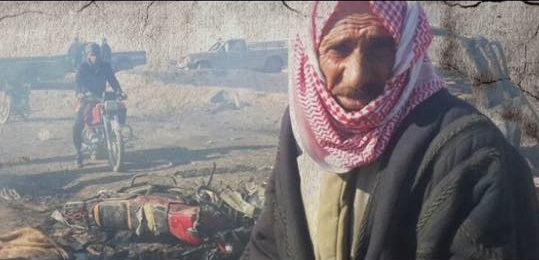In the first 40 weeks of US-led military action against so-called Islamic State (Daesh), more than 3,800 airstrikes were carried out by a dozen international coalition members across both Iraq and Syria. Those strikes saw around 13,000 bombs and missiles dropped in an aerial war likely to continue for many more months, if not years.
Civilian non-combatants already faced great risk on the ground. Islamic State and other militant and terrorist groups have caused untold death and misery to thousands. In Syria, civilians are also repeatedly targeted by the Assad regime in indiscriminate bombings, while in Iraq both the Army and associated militias have been accused of atrocities.
Yet civilians are also at risk from the international coalition’s actions. This is a complex conflict, involving multiple allies fighting across two nations. It is also an intense air war, with Islamic State frequently targeted by airstrikes within the towns and cities it now occupies. Civilian casualties are inevitable.

Ibrahim al Mussul, a shepherd killed with his two daughters Jozah and Zahra in a reported US airstrike on his home, February 2nd 2015 (Syrian Network for Human Rights)
Promoting accountability
Most of the 12 coalition members do issue at least some information about the strikes they conduct – yet there is rarely mention of any casualties inflicted.
With so many nations carrying out bombings, determining responsibility when civilians are killed or injured presents major challenges. We believe there is an acute need for greater openness from our militaries – and our project is an attempt to address this.
Airwars is a non-aligned, not-for-profit organisation seeking to promote transparency and accountability by the US and its allies in the following ways:
* We monitor and record the international coalition’s airstrikes against Islamic State (Daesh) in both Iraq and Syria
* We archive all publicly available official military reports of the war
* We collate – and aim to verify wherever possible – all credible claims of non-combatant civilian deaths.
The Airwars project was begun in August 2014 by journalist Chris Woods, who previously set up and ran the award-winning Drones Project at the Bureau of Investigative Journalism.
“With so many airstrikes being carried out by so many nations in Iraq and Syria – yet with little real transparency or accountability – there is an urgent need for credible independent monitoring,” says Woods. “We know from other recent conflicts that holding combatants to account for their actions can play a significant role in reducing the risk to civilians on the ground.”
Airwars today comprises a small team of professional journalists and researchers. While much of our work is voluntary, thanks to generous funding from the Joseph Rowntree Charitable Trust we also employ two part time specialists – an Iraqi and a Syrian – who monitor Arabic media and monitoring groups, and follow up wherever possible credible claims of civilian casualties.
In March 2015, Airwars transitioned to this purpose-built website thanks to the project’s second core volunteer, data journalist Basile Simon.

Montage of damage from a reported coalition airstrike near Mosul April 20th 2015 (Photo: Mosul Residents Facebook page)
Civilian casualties
Airstrikes can often represent the greatest threat to civilians on the ground during conflicts. And there are plenty of indications that the coalition’s air war against Islamic State places non-combatants at risk of death or injury:
- Coalition strikes are often focused on towns and cities, in both Iraq and Syria. Recent official data showed that at least a third of all coalition airstrikes have been aimed at buildings, for example.
- Most coalition airstrikes are dynamic – that is, they’re aimed at targets of opportunity as opposed to pre-planned operations. As a consequence, little may be known about civilians in the immediate vicinity of a strike location.
- There are very few forward air controllers in Iraq – and none in Syria – meaning the coalition is heavily dependent upon aerial surveillance for accuracy. Yet as Airwars monitoring shows, ISR provision still lags far behind other conflicts such as Afghanistan.
- There appears little or no accountability for coalition actions – crucial if pressure is to be applied to reduce non-combatant deaths. Some nations like Belgium and Saudi Arabia generally refuse to release details of their airstrikes, while others will only say how many bombs they drop – and not where they strike.
Despite these risks, the coalition continues to insist that it cannot officially confirm the death of a single civilian after nine months of airstrikes.
In its latest statement to Airwars dated March 25th, a Pentagon spokesman told us: “It is CENTCOM‘s view that no non-combatant deaths from coalition airstrikes in either Iraq or Syria have officially been confirmed.”
Counting the dead
Instead of the ‘zero civilians killed’ which CENTCOM insists upon, Airwars has identified a significant number of non-combatants likely to have been killed in coalition strikes.
Our early findings have (as of May 13th 2015) identified 95 incidents of concern, in which between 587 and 734 civilian non-combatant fatalities have been claimed.
Many of these events represent significant challenges to our researchers. That said, it is our present view that there are reasonable indications of between 370-465 non-combatant deaths likely to have been caused by coalition strikes.
A further 130-145 deaths are presently poorly reported, or are single-sourced. And an additional 85-125 fatalities result from a contested event (for example, alongside claims that the Iraq military might instead have been responsible.)
Our researchers have also identified 140 or more ‘friendly fire’ deaths of allied ground forces which have been attributed to the coalition, with varying levels of certainty.

Four year old Abdullah Ghassan Salem al Hadid, killed with his family in a reported coalition airstrike on Mosul, Iraq on April 23 2015
“Claims by the coalition that it has killed few or no civilians in its many thousands of airstrikes are not borne out by the evidence,” says Woods. “For numerous events, we have detailed information regarding non-combatants killed – and confirmed coalition strikes in the immediate vicinity. Yet there is little evidence the international alliance is following up on such cases.
“The coalition needs to improve both its post-strike investigations, and to acknowledge promptly and publicly any non-combatant fatalities. Failure to do so risks undermining support among Iraqi and Syrian civilians for ongoing operations – and also hands a propaganda tool to those opposing international intervention.”
If, as expected, the coalition’s airwar continues for some time, Airwars believes there is a vital public interest in its continuing to monitor, scrutinize and challenge military and government narratives of the war.
Experience from previous conflicts such as Afghanistan also indicates that sustained public scrutiny can help to reduce the risk to non-combatants on the battlefield.
Archiving the war
Another important role for Airwars is to gather and permanently archive public military records of the war.
Already the Daily Reports section of our website has collated hundreds of official releases by the US and other militaries. We cross-reference these records where possible against claims of civilian casualties, and also archive video, photographic and other evidence of strikes and their consequences.
There are important reasons for doing this. Official digital records of recent conflicts have proven highly vulnerable to amendment or deletion.
Records of the recent Afghanistan conflict have already fragmented, with CENTCOM only making available records dating back four years. Researchers then have to re-obtain such data using Freedom of Information requests, a laborious and time-consuming process. The British government too has removed daily reports published as recently as 2012.
April 5: RAF reports Tornado strike at Ramadi
April 16th: Strike details are gone
This is why we archive everything. pic.twitter.com/zZBUFVPZXz— Airwars (@airwars) April 16, 2015
Already in the present coalition air war, some records have disappeared from the public record. On April 5th for example, the UK reported an airstrike by one of its Tornados at Ramadi in Iraq [see above]. Eleven days later that record was removed.
By publishing all official reports as they are released, our aim is to archive the entire air war, ensuring that future researchers have full public access to records as they were issued.
For our latest news on coalition strikes follow Airwars on Twitter
